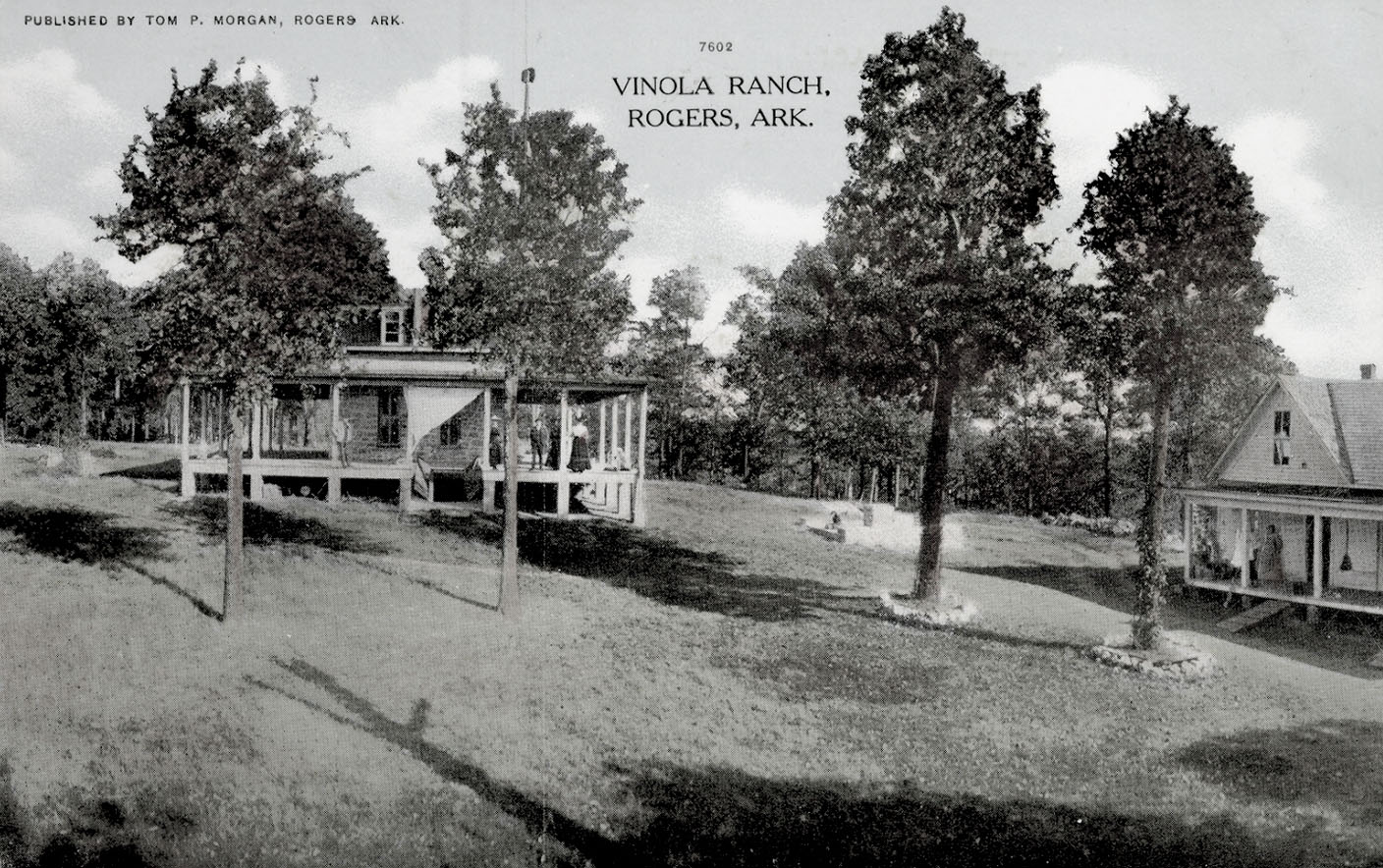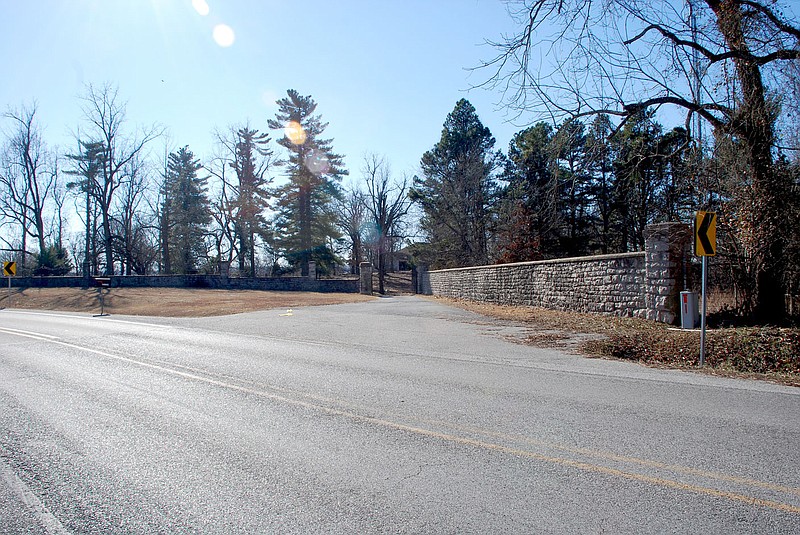Just outside of Rogers, near Monte Ne, there is an impressive home and estate that has an amazing history with noteworthy and colorful characters who lived there. The place is known to many old timers as the Dur Estate, and here is part of its amazing story.
Carl Starck came to Rogers in 1888, just seven years after the founding of the new town. Carl and his brother, Arlie, and their sister, Emmy, along with their mother, Mrs. Emilie, acquired 640 acres just southeast of Rogers near Silver Springs. This land today is just across the road from the Arkansas 94E Fire Department just past Monte Ne. Mrs. Emilie Starck was a widow and a native of Germany and appeared to come from a family of great wealth and refinement. The local hill folks were amazed when the Starcks arrived with two grand pianos, a fine library, beautiful paintings, fine artworks, fine china, glassware, and even gold dinnerware. (Dorothy Mitchell, Our Family magazine, October 1965)
Before coming to Arkansas, Carl was a lawyer with the U.S. Department of Commerce in Washington, D.C., and Arlie was a lawyer in Philadelphia. The boys retired from their former jobs and set out to find the perfect location and weather to raise grapes for fine wines. They considered locations in California and Florida but chose a hillside overlooking the White River near Rogers. In 1890, the Starck brothers named their place the Vinola Wine Ranch and planted one acre of grapes. They are credited with introducing grape growing to Benton County. Unfortunately, siblings Arlie and Emmy suffered premature deaths, but Carl, an accomplished lawyer, scientist, philosopher and horticulturist, went on to make significant contributions to the formation of Rogers and Northwest Arkansas.
Carl Starck experimented with several varieties of grapes and created new varieties before deciding that Cynthiana, an American native grape, produced the best wine. His wines won major awards in this country and abroad, and in 1899, he was appointed by the governor of Arkansas as the state's first wine inspector. By 1900, the Vinola Wine Ranch had grown to 1,235 acres and cultivated more than 8,500 grape vines, 1,000 Arkansas black apple trees, and considerable corn, clover and fodder . (It is interesting to note that the Arkansas Black Apple was developed in 1870 near Bentonville.) In addition to his own farming interests, Starck tested 41 different varieties of grapes as a United States experiment station. (Rogers Democrat, March 2, 1900)
About 1902, Carl Starck built a new home of local limestone on a hill overlooking the White River Valley with 20-foot-wide porches on three sides. The cellar was lined with stone and filled with wooden barrels for aging wine. On the hill near his home, he built a tower for weather observation. His home and Vinola Ranch were the showplace of the area and attracted thousands of tourists every year. He especially welcomed faculty and students from the University of Arkansas to do horticultural experiments.
The Starcks were very kind and hospitable folks and welcomed all to tour their ranch, handing out liberal samples of their products. Carl Starck was happy to give visitors free samples, but he also sold it by the barrel, jug, bottle or glass.
During Starck's wine making career, he continually struggled with prohibition type laws that inhibited his business. At times he advertised his wine "for medicinal purposes only" and for "family use and physicians and hospital purposes." Starck was said to have sold little of his wine locally, instead shipping it to other states. Finally in 1915, when statewide prohibition passed, Starck gave up, lost all interest in wine making, and abandoned his vineyards. (Rogers Historical Museum website, July 2009)
After giving up making fine wines, Starck continued his many other interests including his hobby of being a weather observer for the U.S. government. Before his death in 1939, he received official recognition and awards for reporting the local weather. From 1894, he reported the average temperature, rainfall and frost dates for 45 years without missing a single day. His reports were an indispensable service to the farmers of Northwest Arkansas. (Dorothy Mitchell, Our Family magazine, October 1965)
On Oct. 25, 1922, Carl Starck sold his home and the Vinola Ranch to Jack Dur, a wealthy businessman from Oklahoma City. Carl bought another farm east near Horseshoe Bend Park and moved his family and belongings to their new home. However, prohibition agents refused to let Carl move his treasured barrels of fine aged wine from the cellar of his old home to his new home. Instead, the government agents poured 30 barrels of wine down the holler near the present Arkansas 94E Fire Department.
The Dur home and estate was acquired by local businesspersons Joe and Betty Baker in 1990, and they live there today. Joe and Betty are avid historians and collectors of historical stories and objects. They graciously let me ask questions and filled in the story of Vinola since it was sold by Carl Starck. Here are excerpts of the story:
Jack Dur intended to use the former Vinola ranch as his summer home, and he tore down Starck's old house and built a new home on the site preserving Starck's wine cellar as his basement. Dur used the stone from Starck's house to build the elegant stone and wrought iron fence that you see today along Arkansas 94 East across from the fire station. In the 1930s, the Great Depression was in progress, and the future was uncertain. Dur was afraid of being bombed, so he built his home with 18 inch thick concrete walls -- essentially bomb proof. The home has been upgraded through the years but is still basically as Dur built it and is still known today as the Dur place. (Joe Baker, January 2017)
The Dur family sold the place about 1971, and it had several owners including Charlie Banks, a local Realtor and developer, before it was acquired by Jerry Haskins about 1981. According to Patsy Simmons, who worked for Banks at the time, Haskins came into their office with a sack full of $100 bills and bought the Starck/Dur Estate.
Before coming to Rogers, about 1970, Jerry Haskins worked with Champlin Firearms and designed the original Champlin rifle action. He set up his own Haskins Rifle Co. in 1971 in the appropriately named Rifle, Colo. The initial plan for the Haskins Rifle Company was to produce 200 commemorative rifles to celebrate the 1976 bicentennial of the 1776 Declaration of Independence. Jerry Haskins worked with another rifle maker, Glenn Ems, on the overall design and manufacture of these rifles. However, only a few of these rifles were produced.
I was unable to find details, but about 1980, he moved to Rogers, bought the Dur Estate and continued to design rifles. Haskins was a talented gunsmith and inventor and installed a machine shop and shooting range in the basement of his garage, a separate building near his home. He had a truly brilliant and innovative mind and developed specialized guns and ammunition that received world acclaim. His sniper rifles were the forerunners to modern weapons used today. In the 1980s, he designed .22 caliber rifles for Daisy to be used by the military, and a .50 caliber sniper rifle for the U.S. Navy Seals. Haskins worked with Daisy here in Rogers to design and build the sniper rifles which successfully hit targets at 1,500 meters, just short of one mile. (Daisy, It All Starts Here by Joe Murfin)
I talked to John Ford, who worked for Daisy and witnessed a demonstration about 1987 at Aberdeen Proving Grounds in Maryland.
"Jerry Haskins and Earl Reddick worked together on the sniper rifles. Earl demonstrated the .50 caliber at 1,500 meters. The first shot was a little off, and Earl made some minor adjustments. The second shot exploded the target, an amazing feat," said Ford. "I remember at the time that there were lots of 'secret' meetings at night with Pentagon officials. Jerry Haskins was a genius for designing and building one-of-a-kind guns, but not so much for production," said Ford.
The development of Rogers included many fascinating leaders and their achievements, and some of the foremost and most unusual were Carl Starck , Jack Dur and Jerry Haskins. Hopefully, now travelers who pass the beautiful stone and cast iron fence on the way to Horseshoe Bend Park will notice it and think of the amazing stories that happened there.
 Carl Starck built his two-story home with 20-foot wide porches and a large wine cellar for storing and aging the fine wines produced on the Vinola Ranch. It was made of native limestone. The stone from the house was later used by Jack Dur to build the elegant fence across from the Arkansas 94E Fire Department. (Courtesy image/Rogers Historical Museum)
Carl Starck built his two-story home with 20-foot wide porches and a large wine cellar for storing and aging the fine wines produced on the Vinola Ranch. It was made of native limestone. The stone from the house was later used by Jack Dur to build the elegant fence across from the Arkansas 94E Fire Department. (Courtesy image/Rogers Historical Museum)
